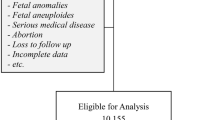Abstract
Introduction
First-trimester screening according to Nicolaides uses maternal age to obtain a common background risk for trisomy 21. The likelihood ratios by nuchal translucency, free β-human chorionic gonadotropin and pregnancy-associated plasma protein-A are not with respect to maternal age. It was the aim of this study to investigate if likelihood ratios should better take care of it.
Materials
Pearson’s correlation and different models of regression analysis had been performed on the results of 8,116 first-trimester screenings. The total number of pregnancies was subdivided into three subgroups of healthy fetuses (n = 8,038); fetuses with Down’s syndrome (n = 46) and fetuses with other genetic abnormalities (n = 32). Statistical testing was applied to each of the three groups.
Results
Strong independence from maternal age could be found for each of the first-trimester screening measurement parameter, as well for healthy and as for affected fetuses. Neither Pearson’s test nor nonlinear regression models could detect a correlation. Accordingly significance of Pearson’s test is not given.
Discussion
First-trimester screening would not be improved by considering the maternal age in the calculation of the likelihood ratios. Therefore the currently used algorithm is adequate. According, to the results, it seems to be proper as well to disregard the maternal age in newer test strategies advanced first-trimester screening (AFS) at all.



Similar content being viewed by others
References
Biagotti R, Petri E, Cariati E (1994) Humerus and femur length in fetuses with Down syndrome pregnancies. Obstet Gynecol 84:844–847
Bromley B, Doubilet P, Frigoletto FD Jr, Krauss C, Estroff JA, Benacerraf BR (1994) Is fetal hyperechoic bowel on second-trimester sonogram an indication for amniocentesis? Obestet Gynecol 83:647–651
Cicero S, Curcio P, Papageorghiou A, Sonek J, Nicolaides KH (2001) Absence of nasal bone in fetuses with trisomy 21 at 11–14 weeks of gestation: an observational study. Lancet 358:1665–1667
Krampl E, Wertaschnigg D, Husslein P (2002) Down-syndrom-Screening im ersten Trimenon. Geburtshilfe Frauenheilk 62 (9):843–848
Malone FD, Canick JA, Ball RH, Nyberg DA, Comstock CH, Bukowski R, Berkowitz RL, Gross SJ, Dugoff L, Craigo SD, Timor-Tritsch IE, Carr SR, Wolfe HM, Dukes K, Bianchi DW, Rudnicka AR, Hackshaw AK, Lambert-Messerlian G, Wald NJ, D’Alton ME (2005) First- and second-trimester evaluation of risk (FASTER) research consortium. First-trimester or second-trimester screening, or both, for Down’s syndrome. N Engl J Med 353(19):2001–2011
Nicolaides KH, Sebire N, Snijders RJM (1999) Die Ultraschalluntersuchung der Schwangerschaftswoche. Pathenon Publishing, Birmingham, pp 11–14
Schmidt P, Scharf A (2006) Advanced first-trimester screening—a critical review of the fundamental studies and suggestions for improvement. Geburtsh Frauenheilk 67:S1–S183
Schmidt P, Staoulidou I, Soergel P, Hillemanns P, Scharf A Advanced first trimester screening (AFS): an improved test strategy for the individual risk assessment of fetal aneuploidies and malformations. Arch Obstet Gynecol (in press)
Schuchter K, Wald N, Hackshaw AK, Hafner E, Liebhart E (1998) The distribution of nuchal translucency at 10–13 weeks of pregnancy. Prenat Diagn 18:281–286
Simpson JM, Cook A, Sharland G (1996) The significance of echogenic foci in the fetal heart: a preospective study of 228 cases. Ultrasound Obstet Gynecol 8:225–228
Snijders RJM, Shawa L, Nicolaides KH (1994) Fetal choroid plexus cysts and trisomy 18: assessment of risk based on ultrasound findings and maternal age. Prenat Diagn 14:1119–1127
Snijders RJM , Noble P, Sebire N, Souka A, Nicolaides KH (1998) UK multicentre project on assessment of risk of trisomy 21 by maternal age and fetal nuchal translucency thickness at 10–14 weeks of gestation. Lancet 351:343–346
Wapner R, Thom E, Simpson JL, Pergament E, Silver R, Filkins K, Platt L, Mahoney M, Johnson A, Hogge WA, Wilson RD, Mohide P, Hershey D, Krantz D, Zachary J, Snijders R, Greene N, Sabbagha R, MacGregor S, Hill L, Gagnon A, Hallahan T, Jackson L (2003) First-trimester screening for trisomy-21 and 18. N Engl J Med 349:1405–1413
Wickstrom EA, Thangavelu M, Parilla BV, Tamura RK, Sabbagha RE (1996) A prospective study of the association between isolated fetal pyelectasis and chromosomal abnormality. Obstet Gynecol 88:379–382
Author information
Authors and Affiliations
Corresponding author
Rights and permissions
About this article
Cite this article
Schmidt, P., Pruggmayer, M., Steinborn, A. et al. Are nuchal translucency, pregnancy associated plasma protein-A or free-β-human chorionic gonadotropin depending on maternal age? A multicenter study of 8,116 pregnancies. Arch Gynecol Obstet 276, 259–262 (2007). https://doi.org/10.1007/s00404-007-0342-4
Received:
Accepted:
Published:
Issue Date:
DOI: https://doi.org/10.1007/s00404-007-0342-4




